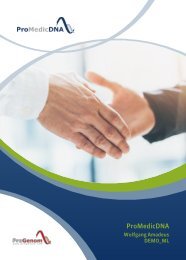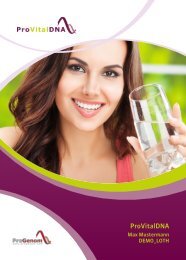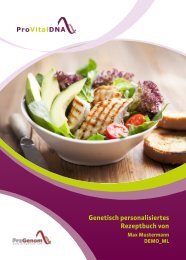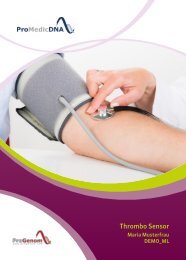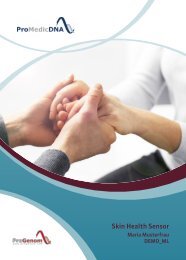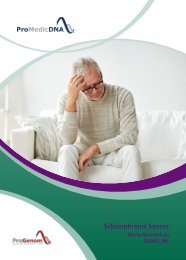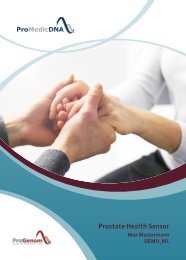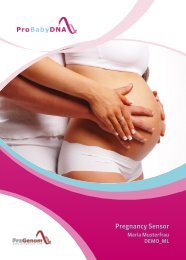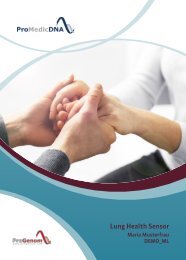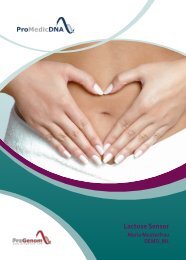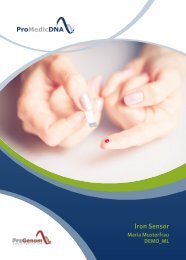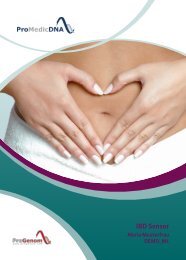ProVitalDNA - Package - DEMO EN
non-medical analysis - ProVitalDNA
non-medical analysis - ProVitalDNA
You also want an ePaper? Increase the reach of your titles
YUMPU automatically turns print PDFs into web optimized ePapers that Google loves.
METABOLISM<br />
Prevention<br />
PHASE 2 DETOXIFICATION: Your genes lead to reduced Phase 2 detoxification.<br />
Therefore, your body does not eliminate certain pollutants efficiently. You should<br />
familiarize yourself with the potential sources of these pollutants, and reduce the<br />
contact with them as much as possible. You should avoid the following sources:<br />
MERCURY<br />
Most uses of mercury are not allowed in Europe because of its toxicity. However, dental<br />
amalgam fillings still contain traces of mercury, so it would be advisable for you to use other<br />
materials for fillings. Selenium is an effective mercury detoxifier, and should be included in<br />
your diet. Eat a balanced diet, rich in nuts, or use dietary supplements that contain selenium.<br />
LEAD<br />
Dust containing lead is the main cause of lead contamination. The main sources of lead dust<br />
are the lead industry, coal-burning power plants, and vehicle emissions. People who work in<br />
plants that produce or process lead are exposed to the most lead. Try to reduce any contact<br />
with sources of lead, for example by using respiratory protection. In highly polluted regions,<br />
lead can be contained on dust that falls on plants. This dust may be removed by careful<br />
washing. Lead contained in plates and dishes can be ingested when eating acidic food (fruits,<br />
wine, vegetables). Therefore, avoid dishes that contain lead. Calcium is an important<br />
component in the lead detoxification. Eat a diet rich in calcium (including dairy products and<br />
dark green vegetables) or use dietary supplements that contain calcium.<br />
CADMIUM<br />
Cadmium is mostly ingested through food. Cadmium-rich foods include liver, mushrooms,<br />
mussels and other shellfish, cocoa powder and dried seaweed. Another important source of<br />
cadmium is flax seed, and as such, particularly genetically susceptible people are advised to<br />
limit their intake of flax seed to no more than 20g per day. In addition, since the introduction<br />
of artificial fertilizers, cadmium finds its way into almost all types of food. Even tobacco smoke<br />
transports relatively large quantities of cadmium to the lungs, from which it is transported<br />
into the entire body. Try to base your diet on organic products, which are produced without<br />
artificial fertilizers, and refrain from smoking. Use adequate respiratory protection if your<br />
working environment is polluted with cadmium. Zinc is an important component for the<br />
cadmium detoxification process. Follow a diet rich in zinc (for example, seafood) or use dietary<br />
supplements that contain zinc.<br />
CHEMICALS<br />
Pollutants found in industrial solvents, herbicides, fungicides or insecticides can also have a<br />
negative impact on your health. Try to base your diet on organic products, and carefully wash<br />
vegetables and fruits before eating them. Avoid skin contact with industrial solvents, and use<br />
adequate respiratory protection when working with these agents.<br />
<strong>DEMO</strong>_ML Page 128 of 295




